 For whole sections of the international media, the "Qana massacre" at Khuraybah was a godsend. It provided tangible support for the narrative they had been running ever since the re-opening of hostilities in Lebanon - and before - that Israel was the pitiless aggressor which would stop at nothing to get its way, including "murdering" innocent women and children.
For whole sections of the international media, the "Qana massacre" at Khuraybah was a godsend. It provided tangible support for the narrative they had been running ever since the re-opening of hostilities in Lebanon - and before - that Israel was the pitiless aggressor which would stop at nothing to get its way, including "murdering" innocent women and children.Thus did newspapers like the British left-wing Independent revel in the pictures produced so obligingly by the agencies and staff photographers, this newspaper devoting its whole front page (left) to "White Tee-shirt's" iconic expression of agony. The only problem for it, and the hundreds if not thousands of newspapers and TV channels that reproduced this and many other images, was that they were fake. Not fake in the sense that they had been doctored - as in the infamous photographs taken by Reuters' Adnan Hajj - but in the very real sense that the scenes has been staged. They were artificial, devised entirely to create shots that the media would lap up - a grisly exercise in propaganda by a terrorist organisation which had its own agenda. And the media did lap them up.
Yet, despite good evidence produced by this blog - and relayed by several thousand other websites - seen by millions of readers (over a million on this site alone) -this issue has not been addressed by the media, either on the ground or back in the comfortable, air conditioned editorial offices, thousands of miles from the action. There, pictures of death are a commodity. It does not seem to matter under what circumstances they were gained, and to what purpose the actors paraded their emotions. Another forest-load of dead trees conveyed the story and a few dead children were exploited to provide pictures and add drama.
 To an extent, this is understandable. Pictures are a commodity and, in the rush of producing a newspaper, they are treated as such. Those from "trusted" sources, like the main news agencies, are largely accepted uncritically and used freely as needed.
To an extent, this is understandable. Pictures are a commodity and, in the rush of producing a newspaper, they are treated as such. Those from "trusted" sources, like the main news agencies, are largely accepted uncritically and used freely as needed.Quite how much of a commodity is revealed by a note from AP to its "staffers" leaked to Little Green Footballs congratulating Beirut-based photographer Hussein Malla, AP photographers Nasser Nasser, Lefteris Pitarakis and stringer Mohammed Zaatari, and Kevin Frayer for their "powerful images". The note in particular observed:
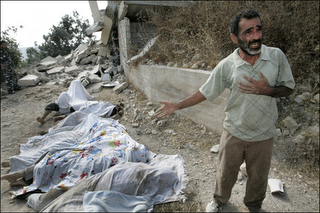
Nasser's most haunting image showed a man emerging from the rubble carrying the lifeless and dust-covered body of a child. Calm, morning light shone down on man and child, highlighting them against an almost monochrome background of pure rubble. ... Nasser's image ran on the front pages of at least 33 newspapers, including the San Francisco Chronicle, Chicago Tribune, The Philadelphia Inquirer and the New York Post. It also won a double-page center spread in The Guardian of London. Lefteris's image (above left) of a resident weeping next to a row of bodies made the front of The Washington Post, among many others.For their work, the "team" shared the week's "$500 Beat of the Week award".
But what is neither understandable nor forgivable is the response of the main agencies when their work was questioned. Only a day after this blog had first published evidence that the photographs had been faked - although how comprehensively and cynically, even we were not fully aware - Associated Press fronted a "rebuttal" on behalf of itself, AFP and Reuters, using its established and privileged relationship with the media to distribute a "rebuttal" of our claims. The news agencies stood by their photographs, we were told.
As other media organisations piled in with their condemnation - some overt like the Washington Post, and others feline like the British Guardian and even the supposedly right-wing Daily Telegraph website (re-named by us, The Daily Hezbollagraph), the agencies maintained a lofty silence. Even on issues which could have been resolved by information only they had, they were silent. But, as the evidence piled up, we issued a direct challenge to the agencies - to refute our findings or come clean and mount an inquiry, publishing their own findings.
 They did neither. Instead, the self-appointed leader of a group of organisations that has become purveyors of lies responded to that charge by producing yet more lies. That was Associated Press, which produced a faux eulogy of "Green Helmet", picked up by Little Green Footballs, amongst others
They did neither. Instead, the self-appointed leader of a group of organisations that has become purveyors of lies responded to that charge by producing yet more lies. That was Associated Press, which produced a faux eulogy of "Green Helmet", picked up by Little Green Footballs, amongst othersThe picture produced with the story, itself was another lie. Divested of his trade-mark green helmet, and orange high-visibility waistcoat, Salam Daher, as we then knew him, was shown with blue helmet and flak jacket. This, as any observer of the scene would have known, is the garb adopted by media personnel in the field (and especially in Lebanon), which made it highly probable that "Green Helmet" had been loaned the kit for yet another staged shot by an AP photographer.
 At least, in this instance, the caption admitted the picture had been posed, with the words "sits to be photographed", but the fact remained that this was obviously a calculated rejection by AP of the charge that its staff had been complicit in the staging of scenes at Khuraybah on 30 July 2006.
At least, in this instance, the caption admitted the picture had been posed, with the words "sits to be photographed", but the fact remained that this was obviously a calculated rejection by AP of the charge that its staff had been complicit in the staging of scenes at Khuraybah on 30 July 2006.AP also offered another photograph of "Green Helmet" (right), this time an internal shot where he was fully kitted up in the borrowed rig. Readers unfamiliar with the background to the story must have been puzzled as to why he was called "Green Helmet" when he was so splendidly decked out in a blue helmet.
Anyhow, this outrageous "puff" followed the initial denial of 3 August, when Kathleen Carroll, senior vice president and executive editor for Associated Press, claimed that she had personally spoken with photo editors, who had dismissed the idea of any wrongdoing. Furthermore, she said, "I also know from 30 years of experience in this business that you can't get competitive journalists to participate in the kind of (staging) experience that is being described." She also claimed that photographers were experienced in recognising when someone was trying to stage something for their benefit.
 It was this, as we indicated in our introduction, that convinced us we should respond with a comprehensive post, pulling together all the evidence of the "staging" at Khuraybah which was then scattered throughout this blog, presenting it as our definitive work. In the ensuing period, much of the information came from readers, and the narrative was informed by the thousands of comments that poured in (2-300 e-mails a day, plus hundreds of comments on our forum). This is the result - no longer an individual effort but a joint production of the "blogosphere".
It was this, as we indicated in our introduction, that convinced us we should respond with a comprehensive post, pulling together all the evidence of the "staging" at Khuraybah which was then scattered throughout this blog, presenting it as our definitive work. In the ensuing period, much of the information came from readers, and the narrative was informed by the thousands of comments that poured in (2-300 e-mails a day, plus hundreds of comments on our forum). This is the result - no longer an individual effort but a joint production of the "blogosphere".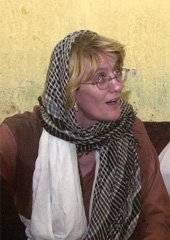 One of the things we did was take a brief look at the egregious Kathy Gannon. Described in the Green/Blue helmet piece as an "Associated Press Writer", she was and is much more than that. Between 1986 and 2005, she was a correspondent for the Associated Press in Pakistan and Afghanistan. She is currently the Iran Bureau Chief-designate.
One of the things we did was take a brief look at the egregious Kathy Gannon. Described in the Green/Blue helmet piece as an "Associated Press Writer", she was and is much more than that. Between 1986 and 2005, she was a correspondent for the Associated Press in Pakistan and Afghanistan. She is currently the Iran Bureau Chief-designate.Her work has been published in Foreign Affairs and The New Yorker. "I is for Infidel" — on the history and politics of Afghanistan during her years working in the region — is her first book. In 2002, she was the recipient of the International Women's Media Foundation's Courage in Journalism award and in 2004, she was the Edward R. Murrow fellow at the Council on Foreign Relations. This was no lowly staff hack doing a routine filler. This was the "big guns", out to do a hatchet job. And thus did she attempt to turn the cynical, manipulative and totally unscrupulous "Green Helmet" in to a latter-day saint, the "hero of Qana", a man who spent "hours of digging in the blistering heat".
This, in fact, was her second attempt at so doing, the first on the day of the incident itself where, awarding the man a different name, she wrote for AP:
Abu Shadi Jradi pulled bodies out of wreckage for hours - two toddler girls wearing tiny gold earrings, a small boy whose pale blue pacifier still hung from his neck. Somewhere in the middle, Jradi slumped beneath a tree and wept.Not least, with the same man being given two different names, one might ask what happened to this famous fact-checking.
 Returning to the point, however, if there is one iconic scene which to us sums up the cynicism of the "rescue" effort, it was not Lefteris Pitarakis's image of a resident standing next to a row of bodies weeping but the shot of the same man sitting inside the wrecked building - the one which was supposed to be in imminent danger of collapse - actually on the mound of rubble under which people were buried, conducting a prolonged conversation on his cell phone. This he did while Red Cross workers moved round him, pulling bodies from the wreckage.
Returning to the point, however, if there is one iconic scene which to us sums up the cynicism of the "rescue" effort, it was not Lefteris Pitarakis's image of a resident standing next to a row of bodies weeping but the shot of the same man sitting inside the wrecked building - the one which was supposed to be in imminent danger of collapse - actually on the mound of rubble under which people were buried, conducting a prolonged conversation on his cell phone. This he did while Red Cross workers moved round him, pulling bodies from the wreckage.Crucially, Gannon, with a Qana "dateline" to her first piece, was there at the time - and lied. In her second piece, on behalf of her employer, she constructed a total fabrication, the like of which Orwell would have been proud. What is more, having been there and thus not having to rely on second-hand accounts, she must have known she was lying. And we have found her out.
Our case against the media
As to our evidence, we have for convenience organised it into four "Acts" which form the core of our report. Turning to these, in chronological terms, the first dealing with the "dead baby" staging was probably the last. This must have occurred some time after midday, while the main recovery effort started shortly after 9 am and, from the photographic evidence, many of the bodies were probably extracted very quickly indeed.
Nevertheless, in technical terms, much of the pictorial evidence we have is far from satisfactory - largely low definition reproductions of still photographs and poor quality television videos. With such low grade material, there is a limit to how much analysis of specific frames can be done - or is advisable to do. Crucially also, we lack detail of the timings of individual photographs and video sequences, which would have assisted our work. Much of that information must be available to the originators of the material - including the agencies. While they have been critical of our attempts to work out timings, they themselves have furnished no information on these key issues.
 However, as to Act 1, it is not the finer detail on which we rely, but on the evidence of that the baby's body was exposed to seven identifiable photography sessions, in which "Green Helmet" was the central figure in four. Yet, Tim Fadek, a photographer who was at Khuraybah on 30 July, claims in Stern magazine that he did not see evidence of staging. "Everybody was upset," he says:
However, as to Act 1, it is not the finer detail on which we rely, but on the evidence of that the baby's body was exposed to seven identifiable photography sessions, in which "Green Helmet" was the central figure in four. Yet, Tim Fadek, a photographer who was at Khuraybah on 30 July, claims in Stern magazine that he did not see evidence of staging. "Everybody was upset," he says:...it was quite chaotic. When they carried the bodies out of the basement, the workers themselves were finished. When they held a body to the cameras, it was nothing of a pose, but sheer distress and anger: look what they did to our children!
 Curiously, Michael Shaw, writing in the Huffington Post also recruits Tim Fadek in a piece headed: "Qana was not staged". Fadek claims that photographers only had "1½ to 2 seconds" to document the dead children as they were laid in the assembly area, pending transport to the ambulances. The man relies on his innate authority of having been at the site, but he clearly has not accounted for the torrent of images that has been produced. Any number of these (not least the one above) give testament to the opportunities available to photographers and the lengths to which rescue workers went to ensure that they got their pictures. There is no way that Fadek can be telling the truth. Like Kathy Gannon, he too is lying.
Curiously, Michael Shaw, writing in the Huffington Post also recruits Tim Fadek in a piece headed: "Qana was not staged". Fadek claims that photographers only had "1½ to 2 seconds" to document the dead children as they were laid in the assembly area, pending transport to the ambulances. The man relies on his innate authority of having been at the site, but he clearly has not accounted for the torrent of images that has been produced. Any number of these (not least the one above) give testament to the opportunities available to photographers and the lengths to which rescue workers went to ensure that they got their pictures. There is no way that Fadek can be telling the truth. Like Kathy Gannon, he too is lying.As regards "Green Helmet's" displays of the dead baby, certainly, anyone seeing just the one episode when he came out of the wrecked basement and held the body of the baby aloft - in a session that was probably over very quickly - might have come away with the impression that this was a spontaneous gesture by a man displaying "sheer distress and anger". But the totality of the evidence indicates otherwise.
Firstly and indisputably, there was the pre-emergence photography session with "Green Helmet" posing inside the basement, with the body of the baby being unearthed. That he offers two different poses to two different photographers destroys any idea of spontaneity - the man discovering the body and rushing out to display it to the media. Secondly, there are the two additional photography sessions - one clearly posed - involving "Green Helmet". If by any measure the emergence scene can be considered spontaneous, these subsequent sessions cannot.
 Arguably though - and it is arguable - a relatively small number of journalists witnessed the "dead baby" display scene and unless they had also seen the other scenes they may not have realised the extent of the staging. However, as we observed, these scenes came later in the day. Before that, and probably first in the chronology, were the first two scenes involving the Red Cross workers, included as the second Act of our report. Not only was the first quite obviously staged, but it was repeated with a different Red Cross worker. In these scenes, a not inconsiderable number of photo-journalists and cameramen actively participated. No one present at either of them could have come away from Khuraybah saying that there was no evidence of staging.
Arguably though - and it is arguable - a relatively small number of journalists witnessed the "dead baby" display scene and unless they had also seen the other scenes they may not have realised the extent of the staging. However, as we observed, these scenes came later in the day. Before that, and probably first in the chronology, were the first two scenes involving the Red Cross workers, included as the second Act of our report. Not only was the first quite obviously staged, but it was repeated with a different Red Cross worker. In these scenes, a not inconsiderable number of photo-journalists and cameramen actively participated. No one present at either of them could have come away from Khuraybah saying that there was no evidence of staging.Then there was that extraordinary episode of the Red Cross stretcher party coming round the corner into "Stretcher Alley". They set down their burden and then, after the first bearer had made what appeared to be a signal, picked up the stretcher and resumed their journey.
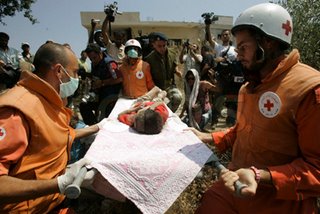 We have focused on these three scenes in particular, but throughout the day it seems that Red Cross workers were willing and active participants in staging other scenes for the benefit of the media - which raises very real questions on the impartiality of the Red Cross.
We have focused on these three scenes in particular, but throughout the day it seems that Red Cross workers were willing and active participants in staging other scenes for the benefit of the media - which raises very real questions on the impartiality of the Red Cross.This picture (above) is one we have not used before was taken by Ali Haider for epa/Corbis. It is indisputably staged: the location is around the corner from the basement opening, in front of the wrecked house, and the stretcher party has actually left the road and is partly down the bank, facing away from the direction of travel. Highly significant is the number of press photographers in the background. Could any of those say - with any honesty - that this photograph (showing the same body that was so intensively photographed as it was brought out of the wrecked basement - see above) was not staged?
Moving on, it is appropriate at this point to deal with Act 4. The first scene deals with the NDR footage which shows "Green Helmet" actively giving camera directions and, quite cynically, staging a photo-opportunity for the television camera. This footage is largely self-explanatory and provides powerful evidence, not only of staging but also of "Green Helmet's" involvement. And, as we observe, the staging was witnessed by a number of journalists. Then there is the "abandoned body" sequence. Seen in the context of the NDR footage, this is yet more evidence of the cynical opportunism of "Green Helmet".
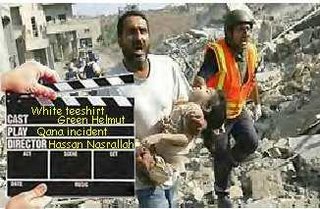 This brings us to Act 3, the "Stretcher Alley" camera runs made by "Green Helmet" and "White Tee-shirt". We have examined both scenes exhaustively and there can be no doubt that the events were staged. Even ignoring the possibility that traffic was sent to the top of the blocked alley, when use of the alternative route could have allowed emergency vehicles direct access to the wrecked house, there were many other factors that strongly support our thesis.
This brings us to Act 3, the "Stretcher Alley" camera runs made by "Green Helmet" and "White Tee-shirt". We have examined both scenes exhaustively and there can be no doubt that the events were staged. Even ignoring the possibility that traffic was sent to the top of the blocked alley, when use of the alternative route could have allowed emergency vehicles direct access to the wrecked house, there were many other factors that strongly support our thesis.Firstly, there the apparent selection process in the assembly area. We find it very hard to believe that the choice of the two bodies - the remains of two photogenic young girls - was accidental. Ample evidence elsewhere demonstrates that Hezbolla have mounted a very effective propaganda campaign, not least in their ability to "tap in" to the western mind and "press the right buttons". Choosing these two "props" could easily have come into that category, giving the western media subjects for their photographs which would not be too offensive to their readers' sensibilities - unlike the "dead baby", images of which were little used in the west.
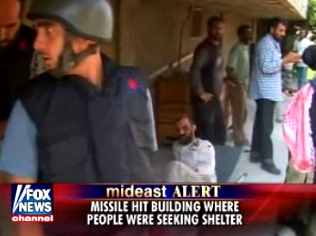 Then there was the dark role of the "staging area". By no means, in the efficient handling of the bodies - arranging their transfer from the wrecked building to the ambulances - could this intermediate area have been considered necessary. Just in terms of efficiency, its use invited double-handling. Then, at the area itself, the conduct of affairs was self-evidently, well... stage-managed.
Then there was the dark role of the "staging area". By no means, in the efficient handling of the bodies - arranging their transfer from the wrecked building to the ambulances - could this intermediate area have been considered necessary. Just in terms of efficiency, its use invited double-handling. Then, at the area itself, the conduct of affairs was self-evidently, well... stage-managed.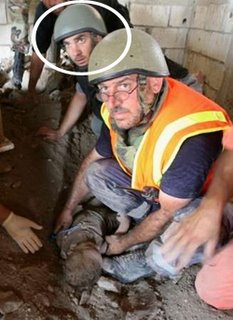 Above is another video "grab" of the area. The man in the foreground, wearing a green helmet of the same design as that worn by the eponymous "Green Helmet" was last seen - in the context of this report - posing with "Green Helmet" in the wrecked basement, as baby Abbas Hashem is uncovered. In the clip, he is seen apparently signalling to the man with the walkie-talkie. Also present are other figures who have played a key role in staging scenes, not least the man in the pale green shirt. All the signs are of preparation for a highly organised, choreographed production.
Above is another video "grab" of the area. The man in the foreground, wearing a green helmet of the same design as that worn by the eponymous "Green Helmet" was last seen - in the context of this report - posing with "Green Helmet" in the wrecked basement, as baby Abbas Hashem is uncovered. In the clip, he is seen apparently signalling to the man with the walkie-talkie. Also present are other figures who have played a key role in staging scenes, not least the man in the pale green shirt. All the signs are of preparation for a highly organised, choreographed production.Next is the choice of the "actors". There is no obvious, logical reason why either "Green Helmet" or "White Tee-shirt" should have been involved in the transfer of the bodies to the ambulances. There were plenty of idle hands in the staging area itself - present long before either of the two actors can been seen - and then there were the two Red Cross workers who transferred the bodies from the wrecked basement to the staging area (with their escorts of empty-handed "minders"). As we have observed, there was absolutely no reason why these Red Cross workers should not have continued their journey past the staging area, direct to the waiting ambulances.
Crucially, there was then the assembly and marshalling of the press corps. Their positioning and the sheer numbers of photo-journalists and television cameramen lining the route - in just the right places for the "iconic" shots - again cannot have been accidental. Their presence, and the signalling systems that gave them advance warning, were clearly part of that highly organised, orchestrated effort.
 That the two "actors" left separately is also inexplicable, except in terms of their phasing their departures to maximise the photo-opportunities. That the bodies were carried rather that stretchered again is only explicable in terms of the opportunities this option afforded for photography. There was, after all, a stretcher available at the other end. If there were none at the staging area, this could have been brought down. That the bodies were not covered also lends support to our thesis.
That the two "actors" left separately is also inexplicable, except in terms of their phasing their departures to maximise the photo-opportunities. That the bodies were carried rather that stretchered again is only explicable in terms of the opportunities this option afforded for photography. There was, after all, a stretcher available at the other end. If there were none at the staging area, this could have been brought down. That the bodies were not covered also lends support to our thesis.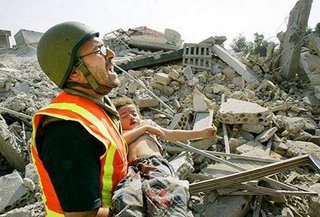 Finally, as actors progressed through their performances, we see their remarkable abilities to switch on their displays of emotion, just where the camera density was highest, to switch them off again and then to re-display for the second tranche of cameras. Given the total lack of spontaneity, it is startlingly clear that these displays were false.
Finally, as actors progressed through their performances, we see their remarkable abilities to switch on their displays of emotion, just where the camera density was highest, to switch them off again and then to re-display for the second tranche of cameras. Given the total lack of spontaneity, it is startlingly clear that these displays were false.Against this huge weight of evidence, what do we have? The bland denials of the agencies, the flawed testimony of Tim Fadek and then Nick Blanford. There have, in fact, been two journalists who have put their heads above the parapet and specifically denied the charges raised by this blog. Blanford who, we have been told, has been working in Lebanon for twelve years for The Times and Time magazine, was one of the first on the spot. He claims:
The Red-Cross people carried the bodies out of the basement one after another. In the beginning, the ambulance had no chance to get to the destroyed building. The rescue workers had to carry the bodies over a distance of 500 metres. That's the reason there are so many pictures of rescue workers with children in their arms.This, against the weight of evidence we have produced, does not even begin to address the issues raised.
Could they have known?
All this notwithstanding, the evidence we have produced is the fruits of considerable labour by many people. The case made, we feel, is very clear that the journalists on site must have been aware of the staging and were complicit in it. Some may even have helped organise some of it.
 However, it is one thing to demonstrate that those on site knew what was happening - it is another to argue that their knowledge was shared by the agency managements which employed them, and by the picture editors and journalists who used their output.
However, it is one thing to demonstrate that those on site knew what was happening - it is another to argue that their knowledge was shared by the agency managements which employed them, and by the picture editors and journalists who used their output.As far as the agencies are concerned, though, this is not a central issue. From AP's own statement of news values and principles, re-issued last on 16 February 2006, the staging of photographs by AP staff is forbidden. Neither are they allowed to use photographs of scenes which third parties have staged, without recording that fact. And if those are the rules, they should be enforced. The question is, therefore, whether "due diligence" was exercised. We see no evidence that it was.
On the other hand, what we do see from Qana is the sheer scale of the staging - not the occasional picture of the many. The majority seems to have been either posed or staged, or both. Given the large AP team present, this suggests that we are looking at more than just a rogue photographer - the malpractice seems institutionalised as normal practice. In the nature of things, this does not happen suddenly. It builds over time before it gets to the stage where wholesale departure from institutional norms becomes standard practice. The presumption must be that local management, at the very least, had broken down - and with it any pretence of quality control.
What then of the newspapers who used the images and the staff who had to make judgements of whether they were acceptable? All they have to go on initially is the photographs themselves and their captions. But, from Deborah Howell of the Washington Post, we get this, in an article written by her about the issue:
Post photo editors are cautious about Middle East photos. "You can't take things at face value. Some freelance photographers lack journalistic training. They are not operating under the same standards as most photographers throughout the world," said Joe Elbert, assistant managing editor for photography. Editors look for manipulation and balance. "We worry about that all the time," he said.This is fair comment and perhaps articulates the concern that all responsible editors in the western media must feel about output from the Middle East. But then, what of the output?

The editors may be thousands of miles from the action but when you get three separate photographs from the same incident, showing quite evidently the same man, each in completely different locations, yet the same man is apparently emoting over the same victim, are there not grounds at least for some suspicion that some or all of the pictures might be staged?
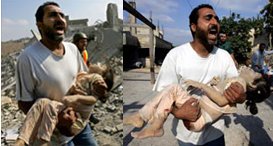
When you then see a different man, in very similar circumstances, again in two wholly different locations, again emoting strongly - in virtually identical poses (in one accompanied by a man who has also been posing thus), would not any reasonable person have some doubts about the authenticity of what they see?
It was precisely these images that raised our suspicions in the first place. And, as many have been quick to point out, we are not the experts. Those experts are the picture editors and the news editors who, we assume, are or should be on their guard against fakes. And they spotted nothing untoward? Nothing? Nothing at all?
Well, Deborah Howell of The Washington Post again cites Joe Elbert and his deputy, Keith Jenkins. They and she, or so she claims, reviewed many photos from Qana. And, she says, "Only one photo, not published, looked staged - of a rescue worker holding a dead child up for the camera. Who took it? Adnan Hajj."
The Washington Post itself used for its front page the picture of the "local resident" in the light green shirt, emoting over the line of corpses outside the wrecked house. Howell must have been satisfied that this was not staged. But did she not stop to ask herself how, in the midst of a frenetic rescue effort, the background in the shot suddenly, miraculously cleared of people - right where the rescue effort was at its most intense. Did she not compare this shot with the many others taken at this angle of the scene and see the buzz of activity? Did she not have the slightest doubts?
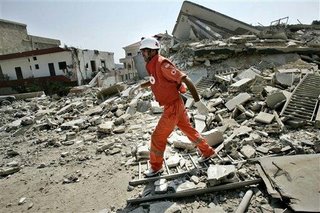 The Washington Post also published this picture (left). It is still up on its website, here. Taken by AP's Lefteris Pitarakis, its original caption, in part, reads: "A Lebanese Red Cross volunteer rushes to the rubble of a demolished building…". Presumably, Deborah Howell and her colleagues checked this photograph as well.
The Washington Post also published this picture (left). It is still up on its website, here. Taken by AP's Lefteris Pitarakis, its original caption, in part, reads: "A Lebanese Red Cross volunteer rushes to the rubble of a demolished building…". Presumably, Deborah Howell and her colleagues checked this photograph as well. But, if you look closely at the picture (double-click to enlarge) you will see the surface over which the Red Cross worker is positioned. Does it look like he could be "rushing" anywhere, without real risk of injury to himself? The pose is so obviously implausible that it has to be staged.
It is our contention, therefore, that even on the limited evidence of a few of the photographs widely in circulation on the day, there were grounds for suspecting a degree of staging. At the very least, some form of investigation should have been conducted. There was certainly time – the images came though from 9 am onwards local time and given the times differences in both Europe and the US, there was no rush at all.
Furthermore, unlike us – where we needed weeks to gather and evaluate the evidence – the newspapers had the resources. They had easy access to a much wider range of photographs than do we. They had the time-stamp information. They had the high definition images. They had the facilities and expertise to evaluate photographs and, all importantly – as customers - they had privileged access to the agencies, whose staff they could question and from whom they could demand further information and explanations. Given the will, any one of the great newspapers who used these images could have found out in hours what we took weeks to establish – that, indeed, the majority of the photographs were staged.
If any of them did carry out any investigations, then clearly the results did not prevent the publication of false images.
Conclusions
Thus, at last, we offer our conclusions. In so doing, we pose the questions that pervade this report, and answer them. Firstly, were many of the scenes during the rescue/recovery effort at Khuraybah on 30 July 2006, staged? The answer has to be yes.
Secondly, were journalists (with or without cameras) aware of the staging and complicit in it? Again, the answer has to be yes.
Third, did the media (the western media in particular) accept the images uncritically, without in any way inquiring as to their authenticity - even though there were good grounds for suspicion? Here, the answer almost certainly has to be yes.
Finally, has there since been a cover-up by the agencies and other media organisations which produced or used the material, and a sustained campaign by them either to ignore the issue or neutralise criticism? Once again, the answer has to be yes.
In defence of the media, if it can be considered thus, one can only postulate that staging scenes such as these is so common a practice, and so deeply embedded in the whole fabric of photo-journalism (and not just locally in the Middle East), that no one at the incident saw anything wrong with what transpired. Either that or, so familiar were they with the techniques used that they simply did not register what was happening. As for the others, in their air-conditioned offices, hundreds and thousands of miles away from the action, did they care one way or the other? After all, as Shane Richmond of The Daily Telegraph implied, the greater truth was being served. "Is the child dead?", he asked. "Was the child killed by Israeli bombs?" Thus, did he say:
If so, the picture illustrates the story. If the picture does not alter the truth of the story, we're not being disingenuous. And the truth of the story is this: Israeli bombs killed several civilians in Qana, many of whom were children.That is the nearest to an admission we have that it is acceptable to stage photographs.
But, by their actions and inactions are the rest condemned. Meanwhile, "Green Helmet" has entered the political vocabulary and the name "Qana" is now associated in the minds of perhaps millions of people with a media that seems to have lost its moral base and has forgotten entirely the purpose for which it exists.
Before preparing this report, we offered a challenge to the news agencies at the centre of this affair, calling for them to admit the wrongdoings carried out in their names, and to clean up their acts. Their response to that has been silence. This is our response. It stands as testimony to their failures which, if they are not addressed, will come back to haunt them.
We will be waiting, and watching.
Richard North PhD
Bradford, England
28 August 2006
(Revised version)
back to the contents page
COMMENT THREAD
No comments:
Post a Comment
Note: only a member of this blog may post a comment.